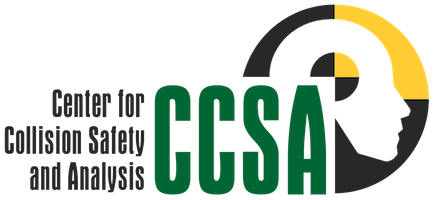The research capabilities of the CCSA Team are rooted in their educational backgrounds and collective experience and accomplishments in past endeavors. They are also based upon their track record in competing for large and small contracts with a variety of sponsors and successfully completing various efforts under these contracts. The Team’s accomplishments have been significant in their breadth of topics covered, global scope, and cutting-edge influences. A brief overview of these aspects of the CCSA capabilities and accomplishments are provided in this section.
Accomplishments
The Center for Collision Safety and Analysis people can boast of many significant accomplishments. While CCSA may have just joined George Mason University, in previous venues working together they can rightfully claim the accomplishments noted below.
Topic Area
Accomplishments
Vehicle Modeling
- Developed & validated FE vehicle models in collaboration with FHWA and NHTSA, including 1994 Chevy C2500 pick-up, 1998 Geo Metro, 1996 Dodge Neon, 2005 & 2006 Ford F250, 2003 Ford Explorer, 1997 Toyota RAV4, 2001 Ford Taurus, 2007 Chevrolet Silverado, 2010 Toyota Yaris, 2012 Toyota Camry, 2014 Chevrolet Silverado, and 2019 Generic ADS Vehicles.
- Developed new methodologies for building detailed FE models (e.g., Chevy Silverado) and conducted extensive validations of the model which included comparisons to NCAP frontal impact tests, inertial properties, and nondestructive suspension response tests.
- Developed new validation tests and worked to apply proposed verification and validation protocols to recently developed models to bolster confidence in the models.
- Established protocols for the testing of materials samples and documentation of FE models.
Roadside Safety Analyses
- Developed finite element models for guardrails, concrete safety shapes, transitions, end treatments, sign supports, breakaway devices, cable barriers, and mailboxes.
- Demonstrated the viability and potentials for using crash simulation in the analyses of the safety performance of all types of roadside hardware.
- Analyzed the effects of guardrail height on safety performance through parametric analyses of varying rail heights using simulation and confirmed the results with full-scale tests.
- Formulated guidelines for the effective slope placement of roadside hardware to optimize positive interface between vehicles and barriers using vehicle dynamics analyses.
- Investigated the interface effectiveness implications of lateral placement of cable median barriers through pioneering applications of vehicle dynamics analysis tools.
- Analyzed effective combinations of shape, length, connections, and other design elements for portable concrete barriers to optimize work zone deployment.
- Evaluated the impacts of proposed new roadside hardware crashworthiness criteria by comparisons of similar impacts with the previous and proposed vehicles (i.e., adding mass).
- Simulated and tested the influences of terrain on the trajectories of vehicles that have left the roadway to understand the effects on crashes.
Vehicle Safety
- Analyzed vehicle-to-vehicle compatibility using crash simulation for front-to-front and front-to-side impacts.
- Conducted vehicle bumper compatibility studies for NHTSA to evaluate structural interaction between passenger cars varying classes of light truck vehicles.
- Developed a load wall design to accurately measure “height of force” for NCAP frontal tests to assess vehicle interaction compatibility.
- Evaluated override barrier design to detect Safety Energy Absorbing Structures in light truck vehicles.
- Analyzed performance of child safety seats in various positions for varying sized children.
- Modeled and evaluated of vehicle roof crush performance to assess alternative proposed dynamic testing approaches.
Crash Data Analyses
- Conducted a comprehensive analysis of motorcycle crashes using FARS & NASS GES data.
- Linked NCAP test data with FARS crashes to assess stiffness effects on crash severity.
- Investigated characteristics of multiple impact crashes that produce serious injuries.
- Used CIREN data to assess the performance of second generation airbags.
Computing & Simulation Technology
- Pursued enhancement of computer technology to speed up crash simulation processing.
- Tested new software elements for LSTC and established computer performance benchmarks.
- Maintained expertise in LS-DYNA and associated pre- & post- processors, MADYMO, HVE, CarSim, and other software.
- Provided benchmark models for the evaluation of computational accuracy, reliability, and consistency in LS‑DYNA and high performance computer hardware.
